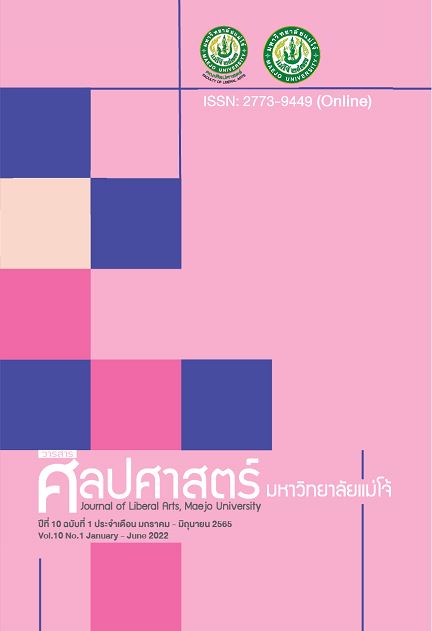กลวิธีการถ่ายทอดลักษณะทางกวีนิพนธ์ในการแปลนิราศเมืองเพชรจากภาษาไทยเป็นภาษาอังกฤษ
Main Article Content
บทคัดย่อ
บทความวิจัยนี้มีจุดมุ่งหมายเพื่อศึกษากลวิธีที่เสาวณีย์ นิวาศะบุตร ใช้ในการถ่ายทอดลักษณะทางกวีนิพนธ์ของนิราศเมืองเพชร แต่งโดยสุนทรภู่ ใน Journey to Phetburi – A Poem by Sunthorn Phu ซึ่งเป็นงานแปลนิราศเรื่องดังกล่าวจากภาษาไทยเป็นภาษาอังกฤษ ในงานศึกษานี้ ผู้วิจัยนำแนวความคิดเรื่อง “อลังการของกวีนิพนธ์” ที่เสนอโดยสุภาพร มากแจ้ง (2535) มาใช้ในการสร้างกรอบการวิเคราะห์ โดยครอบคลุมการศึกษาการถ่ายทอดความงามด้านเสียงและความงามด้านความหมาย ใช้การจำแนกกลวิธีการแปลที่นำเสนอโดย Baker (2011) ประกอบการวิเคราะห์การแปลระดับคำ ใช้การจำแนกกลวิธีแปลโวหารภาพพจน์ของ Larson (1998) ประกอบการวิเคราะห์การแปลโวหารภาพพจน์ และอภิปรายผลที่เกิดจากการเลือกใช้กลวิธีแปลผ่านมโนทัศน์การทำให้กลมกลืน (domestication) และ การทำให้แปลก (foreignization) ที่เสนอโดย Venuti (1995) ผลการวิจัยแสดงให้เห็นว่า 1) ในการกำหนดฉันทลักษณ์ ผู้แปลนำฉันทลักษณ์กวีนิพนธ์ภาษาอังกฤษมาใช้ และมีการสร้างเสียงสัมผัสหลากหลายรูปแบบ 2) ในการแปลคำเลียนเสียงธรรมชาติ ผู้แปลใช้กลวิธีนำคำเลียนเสียงธรรมชาติที่มีในภาษาอังกฤษมาใช้ 3) ในการแปลคำที่มีเสียงและความหมายสัมพันธ์กัน ผู้แปลใช้กลวิธีนำคำที่มีเสียงและความหมายสัมพันธ์กันที่มีภาษาอังกฤษมาใช้ และกลวิธีการถอดความ 4) ในการแปลการซ้อนคำ ผู้แปลใช้กลวิธีการใช้คำที่มีความหมายกว้างกว่า กลวิธีการใช้คำที่มีความหมายเป็นกลางกว่า และกลวิธีการถอดความ 5) ในการถ่ายทอดการเล่นคำและความหมายของชื่อเฉพาะผู้แปลใช้กลวิธีการทับศัพท์โดยมีคำอธิบายความหมายของคำทับศัพท์ในเชิงอรรถ และกลวิธีการให้ความหมายของคำในชื่อเฉพาะเมื่อเป็นคำสามัญไว้ในเชิงอรรถ 6) ในการแปลโวหารเชิงภาพพจน์ ผู้แปลใช้กลวิธีการใช้ภาพพจน์เดียวกันกับภาษาต้นฉบับ ในบางกรณีมีคำอธิบายเสริมในบทกลอนหรือในเชิงอรรถ กลวิธีการแปลอุปลักษณ์เป็นอุปมา และกลวิธีการถอดความ กลวิธีการแปลเหล่านี้แสดงให้เห็นบทบาทของผู้แปลในการต่อรองทั้งด้านสุนทรียลักษณ์และความหมาย เพื่อให้ผู้อ่านได้เข้าใจเนื้อหานิราศเมืองเพชร และได้สัมผัสประสบการณ์ทางวรรณศิลป์ที่ใกล้เคียงกับผู้อ่านต้นฉบับ ซึ่งกระบวนการต่อรองดังกล่าวสะท้อนให้เห็นแนวทางการทำให้กลมกลืน (domestication) และแนวทางการทำให้แปลก (foreignization) ที่แสดงให้เห็นการคงไว้ซึ่งร่องรอยวรรณศิลป์ของกวีนิพนธ์ต้นฉบับ ซึ่งในกระบวนการต่อรองดังกล่าวผู้แปลต้องอาศัยความสามารถทางภาษา การตัดสินใจ และการคิดสร้างสรรค์ของผู้แปลภายใต้ข้อจำกัดของฉันทลักษณ์และทรัพยากรทางภาษาที่มีในภาษาปลายทาง
Article Details

อนุญาตภายใต้เงื่อนไข Creative Commons Attribution-NonCommercial-NoDerivatives 4.0 International License.
ต้นฉบับที่ได้รับการตีพิมพ์ในวารสารคณะศิลปศาสตร์ มหาวิทยาลัยแม่โจ้ ถือเป็นกรรมสิทธิ์ของมหาวิทยาลัยแม่โจ้ ห้ามนำข้อความทั้งหมดหรือบางส่วนไปพิมพ์ซ้ำ เว้นเสียแต่จะได้รับอนุญาตจากมหาวิทยาลัยฯ เป็นลายลักษณ์อักษรเอกสารอ้างอิง
รัชนีโรจน์ กุลธำรง. (2552). ความรู้ความเข้าใจเรื่องภาษาเพื่อการแปล: จากทฤษฎีสู่ปฏิบัติ. กรุงเทพฯ: สำนักพิมพ์แห่งจุฬาลงกรณ์มหาวิทยาลัย.
สุภาพร มากแจ้ง. (2535). กวีนิพนธ์ไทย 1. กรุงเทพฯ: โอเอสพรินติ้ง เฮ้าส์.
อรศิริ พลเดช. (2016). แนะนำหนังสือ นิราศแปล 4 เรื่องของสุนทรภู่ (ฉบับ ไทย-อังกฤษ) โดยเสาวณีย์ นิวาศะบุตร. วารสารการแปลและการล่าม. 1(2), 199-224
Baker, M. (2011). In other Words: A Coursebook on Translation. (2nd ed.). London & New York: Routledge.
Baker, M. (2000). Routledge Encyclopedia of Translation Studies. London & New York: Routledge.
Bassnett, S. (2002). Translation Studies. (3rd ed.). London & New York: Routledge.
Byrne, J. (2010). Technical Translation. Dordrecht: Springer.
Connolly, D. (2000). Poetry Translation. In: Baker, M. (ed.) Routledge Encyclopedia of Translation Studies. London & New York: Routledge.
Holmes, J. (1988) Translated!: Papers on Literary Translation and Translation Studies. Amsterdam: Rodopi.
Larson, M.L. (1998). Meaning-Based Translation: A Guide to Cross-Language Equivalence. (2nd ed.). New York: University Press of America.
Munday, J. (2008). Introducing Translation Studies: Theories and Applications. (2nd ed.). London, New York: Routledge.
Newmark, P. (1988). Approaches to Translation. Oxford: Pergamon Press.
Nivasabutr, S. (2015). Journey to Petchburi – A Poem by Suthorn Phu. (2nd ed.). Bangkok: Mahidol University.
Thornborrow, J. and Wareing S. (1998). Patterns in Language: An Introduction to Language and Literary Style. London & New York: Routledge.
Venuti, L. (1995). The Translator's Invisibility: A History of Translation. London & New York: Routledge.
Yule, G. (2014). The Study of Language. (5th ed.). Cambridge: Cambridge University Press.

